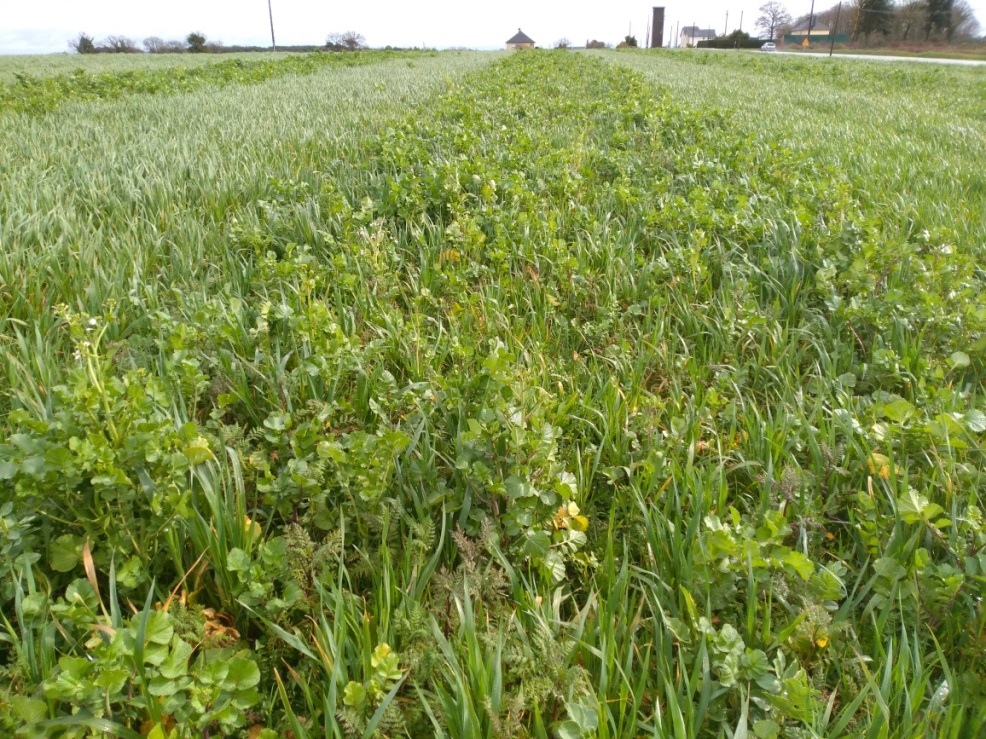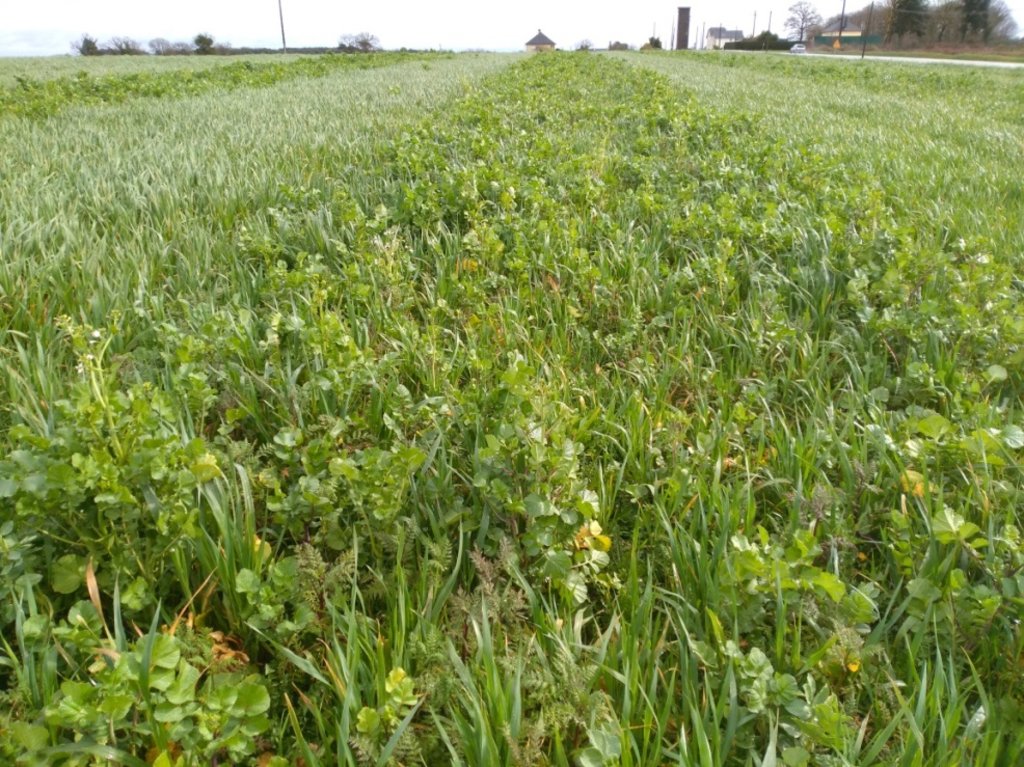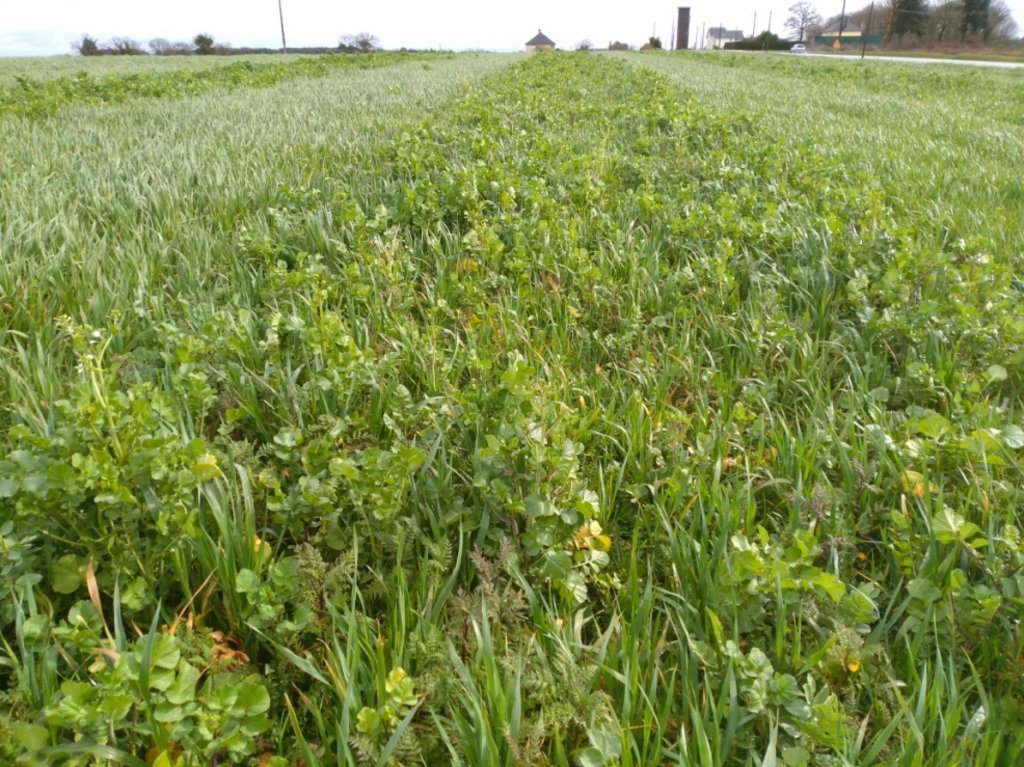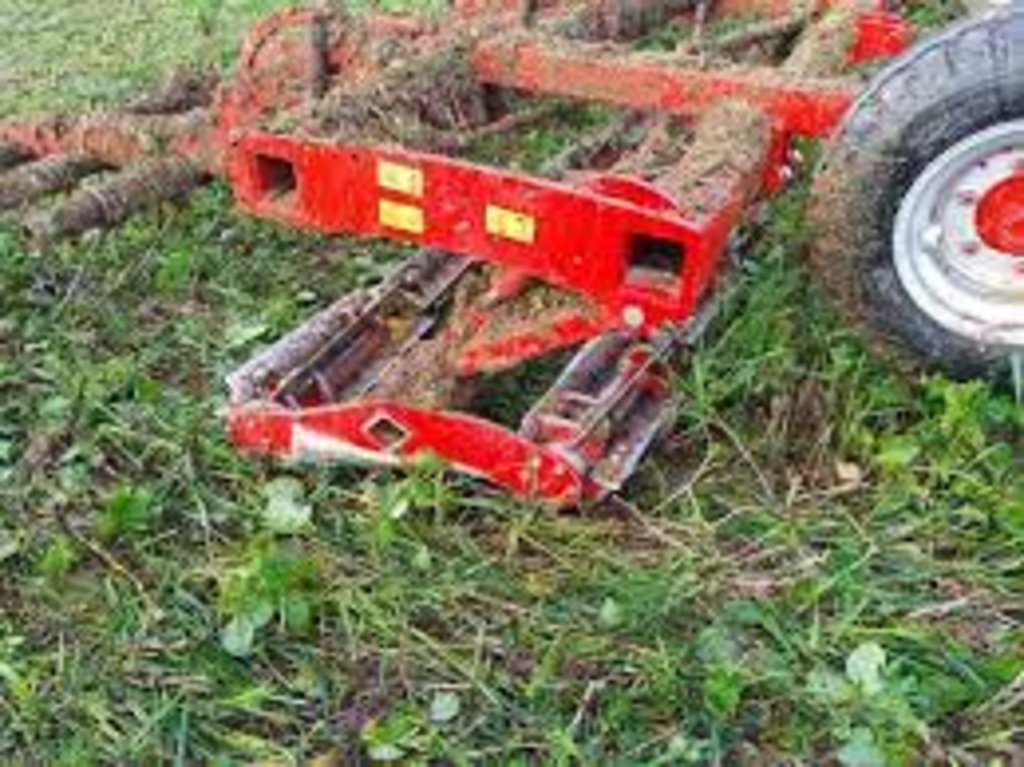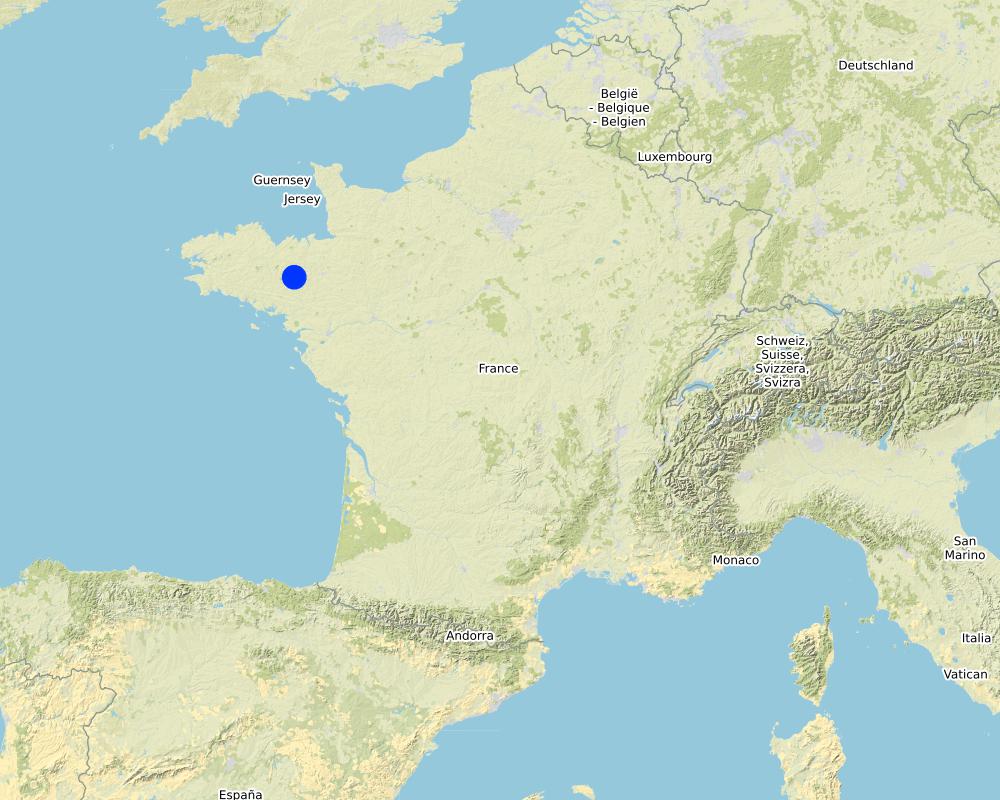Vegetation cover management on an organic, mixed livestock-crop farm [ប្រទេសបារាំង]
- ការបង្កើត៖
- បច្ចុប្បន្នភាព
- អ្នកចងក្រង៖ Alan Radbourne
- អ្នកកែសម្រួល៖ David Robinson, David Norris, Sabine Reinsch
- អ្នកត្រួតពិនិត្យច្រើនទៀត៖ Rima Mekdaschi Studer, William Critchley
technologies_5680 - ប្រទេសបារាំង
ពិនិត្យមើលគ្រប់ផ្នែក
ពង្រីកមើលទាំងអស់ បង្រួមទាំងអស់1. ព័ត៌មានទូទៅ
1.2 ព័ត៌មានលម្អិតពីបុគ្គលសំខាន់ៗ និងស្ថាប័នដែលចូលរួមក្នុងការវាយតម្លៃ និងចងក្រងឯកសារនៃបច្ចេកទេស
បុគ្គលសំខាន់ម្នាក់ (ច្រើននាក់)
co-compiler:
Joubioux Christiane
Chambre regionale d'agriculture de Bretane: Regional chambre of agriculture of Brittany
ប្រទេសបារាំង
អ្នកប្រើប្រាស់ដី:
Le Callonnec Patrice
NA
ប្រទេសបារាំង
អ្នកជំនាញឯកទេស SLM:
Guiet Sylvie
Chambre regionale d'agriculture de Bretane: Regional chambre of agriculture of Brittany
ប្រទេសបារាំង
ឈ្មោះគម្រោងដែលបានចងក្រងឯកសារ/ វាយតម្លៃលើបច្ចេកទេស (បើទាក់ទង)
European Interreg project FABulous Farmersឈ្មោះអង្គភាពមួយ (ច្រើន) ដែលបានចងក្រងឯកសារ/ វាយតម្លៃបច្ចេកទេស (បើទាក់ទង)
UK Centre for Ecology & Hydrology (CEH) - ចក្រភពអង់គ្លេសឈ្មោះអង្គភាពមួយ (ច្រើន) ដែលបានចងក្រងឯកសារ/ វាយតម្លៃបច្ចេកទេស (បើទាក់ទង)
Association des Chambres d’agriculture de l’Arc Atlantique (AC3A) - ប្រទេសបារាំង1.3 លក្ខខណ្ឌទាក់ទងទៅនឹងការប្រើប្រាស់ទិន្នន័យដែលបានចងក្រងតាមរយៈ វ៉ូខេត
អ្នកចងក្រង និង(បុគ្គលសំខាន់ៗ)យល់ព្រមទទួលយកនូវលក្ខខណ្ឌនានាទាក់ទងទៅនឹងការប្រើប្រាស់ទិន្នន័យដែលបានចងក្រងតាមរយៈវ៉ូខេត:
បាទ/ចា៎
1.4 សេចក្តីប្រកាសស្តីពីចីរភាពនៃការពណ៌នាពីបច្ចេកទេស
តើបច្ចេកទេសដែលបានពណ៌នានេះមានបញ្ហាដែលផ្តោតលើការធ្លាក់ចុះគុណភាពដី, បើដូច្នេះវាមិនអាចត្រូវបានប្រកាសថាជាបច្ចេកទេសនៃការគ្រប់គ្រងប្រកបដោយចីរភាពទេ?
ទេ
2. ការពណ៌នាពីបច្ចេកទេស SLM
2.1 ការពណ៌នាដោយសង្ខេបពីបច្ចេកទេស
និយមន័យបច្ចេកទេស:
Use of different mixes of plant cover for livestock fodder which are simultaneously favourable for biodiversity by improving soil health, and reducing the need for agrochemicals.
2.2 ការពណ៌នាលម្អិតពីបច្ចេកទេស
ការពណ៌នា:
Agriculture in Brittany, in the north-west of France, is known for fish, beef, pork, poultry, vegetables and milk. Cover crops are used by farmers of Mauron, and the example described here is from a farm located in Morbihan in the basin known as Ploërmel. In this warm temperate area the average annual rainfall is 650-700 mm with an annual temperature of around 11°C.
There are three types of cover crops included in the rotation. These are selected on the basis of their benefits in relation to soil fertility and fodder production, in order to improve the farm's food self-sufficiency. There are three basic types of cover crops, as follows.
1) “Protein mixes” are composed of 35% faba (broad) beans, 26% oats, 17.5% peas, 17.5% vetch, and 4% clover. These are sown in early October after grass or maize are made into silage at the end of April.
2) "Green manure" cover crops are sown at the beginning of September after cereals, and are composed of various complementary species with the main objective of preserving and strengthening soil life (i.e. worm abundance), and winter feeding of heifers. For example, the commercial "Biomax" mix contains seeds of broad bean, vetch, clover, phacelia and radish. These cover crops are enriched by the presence of approximately 50% ryegrass regrowth, supporting the development of soil life.
3) Rapeseed is sown after cereals as a crop rotation feedstock and are made into silage.
Cover crops are either broadcast and rolled, or direct seeded depending on the conditions of the post-harvest plots. The seed drill used is equipped with discs to minimise soil disturbance as a reduced tillage technique, but more important in this respect is the presence of crop residues (i.e. straw). The seed drill is also equipped with tines.
The cover crops are grazed by heifers in a rotational 2-day paddock set-up. After grazing and regrowth of the ryegrass present, the fields may be left to develop into pasture, or seeded to crops using a minimum tillage drill.
The purposes are:
•Improved production
•Countered land degradation
•Protected watersheds
•Preserved biodiversity
•Adaptation to climate change/extreme events
The benefits are:
•Sustained ecosystem health: no pest and disease problems, good herd health
•Enrichment of the soil by the addition of carbon in organic matter and by the work of earthworms - favouring ecosystem functioning
•Protection of the soil and surface biodiversity because of maintained plant cover
•Increased weed control due to plant canopies and fertilisation effect of green manure
•Planted cover crops used as livestock feed during winter
The challenges are:
•Potential difficulties in establishing plant cover (especially in dry areas)
•Late sowing of cover crops reduces beneficial effects
•High costs of seed mixtures with high protein cover crops
2.3 រូបភាពនៃបច្ចេកទេស
2.5 ប្រទេស/តំបន់/ទីតាំងកន្លែង ដែលបច្ចេកទេសត្រូវបានអនុវត្ត និងបានគ្រប់ដណ្តប់ដោយការវាយតម្លៃនេះ
ប្រទេស:
ប្រទេសបារាំង
តំបន់/រដ្ឋ/ខេត្ត:
Brittany
បញ្ជាក់បន្ថែមពីលក្ខណៈនៃទីតាំង:
Mauron
បញ្ជាក់ពីការសាយភាយនៃបច្ចេកទេស:
- ត្រូវបានផ្សព្វផ្សាយត្រឹមតំបន់មួយ
ប្រសិនបើមិនច្បាស់ពីទំហំផ្ទៃដី សូមធ្វើការប៉ាន់ប្រម៉ាណ:
- 10-100 គម2
តើបច្ចេកទេស (មួយ ឬច្រើន) ទាំងនោះស្ថិតនៅក្នុងតំបន់ការពារជាអចិន្ត្រៃយ៍ណាមួយដែរឬទេ?
ទេ
Map
×2.6 កាលបរិច្ឆេទនៃការអនុវត្ត
បង្ហាញឆ្នាំនៃការចុះអនុវត្ត:
2019
ប្រសិនបើមិនច្បាស់ឆ្នាំ សូមបញ្ជាក់កាលបរិច្ឆេទដែលប្រហាក់ប្រហែល:
- តិចជាង 10ឆ្នាំមុន (ថ្មី)
2.7 ការណែនាំពីបច្ចេកទេស
សូមបញ្ជាក់តើបច្ចេកទេសត្រូវបានណែនាំឱ្យអនុវត្តដោយរបៀបណា:
- តាមរយៈការបង្កើតថ្មីរបស់អ្នកប្រើប្រាស់ដី
- ជាផ្នែកនៃប្រព័ន្ធប្រពៃណី (> 50 ឆ្នាំ)
មតិយោបល់ (ប្រភេទនៃគម្រោង ។ល។):
In order to make their production system evolve, farmers and their associates are eager for information. They do not hesitate to go and see what is happening elsewhere and to consult: training, visits, reading, internet, exchanges. The land user is a member of the BASE (Biodiversity Agriculture Soil and Environment) network and the Ecosystem association. Breeders do not hesitate to test new production practices on their farms.
3. ចំណាត់ថ្នាក់នៃបច្ចេកទេស SLM
3.1 គោលបំណងចម្បង (១ ឬច្រើន) នៃបច្ចេកទេសនេះ
- ធ្វើឱ្យប្រសើរឡើងនូវផលិតកម្ម
- កាត់បន្ថយ, បង្ការ, ស្តារឡើងវិញនូវការធ្លាក់ចុះគុណភាពដី
- ការពារតំបន់ទីជម្រាល/តំបន់ខ្សែទឹកខាងក្រោមបញ្ចូលជាមួយបច្ចេកទេសផ្សេងទៀត
- អភិរក្ស/ធ្វើឱ្យប្រសើរឡើងជីវចម្រុះ
- បន្ស៊ាំទៅនឹងការប្រែប្រួលអាកាសធាតុ/គ្រោះមហន្តរាយ និងផលប៉ះពាល់របស់វា
3.2 ប្រភេទដីប្រើប្រាស់មួយប្រភេទ (ច្រើនប្រភេទ) ដែលបានអនុវត្តបច្ចេកទេស
ដីប្រើប្រាស់ចម្រុះនៅលើដីតែមួយ:
បាទ/ចា៎
បញ្ជាក់ពីប្រភេទដីច្រើនប្រភេទ (ដីដាំដំណាំ/ដីចិញ្ចឹមសត្វ/ដីព្រៃឈើ):
- Agro-pastoralism ( រួមបញ្ចូលទាំងដំណាំ និងចិញ្ចឹមសត្វ)

ដីដាំដំណាំ
- ដំណាំប្រចាំឆ្នាំ
- Cover crops
ដំណាំប្រចាំឆ្នាំ - បញ្ជាក់ប្រភេទដំណាំ:
- ធញ្ញជាតិ - ពោត
- ធញ្ញជាតិ - ស្រូវសាលី
- ដំណាំចំណីសត្វ - ចន្ទល់ភ្នំ
- ដំណាំចំណីសត្វ - ស្មៅ
- ដំណាំចំណីសត្វ - ផ្សេងៗ
- ពពួកសណ្តែក - សណ្តែកបារាំង
- ដំណាំដែលមានគ្រាប់ចម្រាញ់ប្រេងបាន - ផ្កាឈូករ័ត្ន ផ្កា rapeseed ផ្សេងៗ
ចំនួនសារដែលដាំដំណាំក្នុងមួយឆ្នាំ:
- 1
តើជាការអនុវត្តន៍ដំណាំចន្លោះ?
បាទ/ចា៎
ប្រសិនបើបាទ/ច៎ា សូមបញ្ជាក់ប្រភេទដំណាំដែលដាំចន្លោះគ្នានោះ:
protein mix, a multi-species green manure, and a rapeseed mix
តើជាការអនុវត្តន៍ដំណាំវិលជុំ?
បាទ/ចា៎
បើបាទ/ច៎ា សូមបញ្ជាក់:
Maize, grassland

ដីសម្រាប់ចិញ្ចឹមសត្វ
ដីវាលស្មៅតូចៗ/ ផលិតកម្មចំណី:
- កាត់ និងជញ្ជូន/ គ្មានវាលស្មៅសម្រាប់ចិញ្ចឹមសត្វ
- បង្កើនវាលស្មៅ
ប្រភេទសត្វ:
- សត្វពាហនៈ - សត្វចិញ្ចឹមយកទឹកដោះ
- បសុបក្សី
តើជាការអនុវត្តការគ្រប់គ្រងដែលរួមបញ្ចូលការដាំដំណាំ និងចិញ្ចឹមសត្វដែរឬទេ?
បាទ/ចា៎
បើបាទ/ច៎ា សូមបញ្ជាក់:
Dairy and poultry moved across crop for fodder and cross benefits of fertilisation.
ប្រភេទពូជ:
សត្វពាហនៈ - សត្វចិញ្ចឹមយកទឹកដោះ
ចំនួន:
115
ប្រភេទពូជ:
បសុបក្សី
ចំនួន:
4500
3.3 បន្ទាប់ពីអនុវត្តបច្ចេកទេស តើដីប្រើប្រាស់មានការប្រែប្រួលដែររឺទេ?
បន្ទាប់ពីអនុវត្តបច្ចេកទេស តើដីប្រើប្រាស់មានការប្រែប្រួលដែររឺទេ?
- ទេ (បន្តទៅសំណួរ 3.4)
3.4 ការផ្គត់ផ្គង់ទឹក
ការផ្គត់ផ្គង់ទឹកនៅកន្លែងអនុវត្តបច្ចេកទេស:
- ទឹកភ្លៀង
3.5 ក្រុម SLM ដែលបច្ចេកទេសស្ថិតនៅក្នុង
- ការគ្រប់គ្រងដោយរួមបញ្ចូលការដាំដំណាំ និងការចិញ្ចឹមសត្វ
- ធ្វើឱ្យប្រសើរឡើងគម្របដី/ ដំណាំគម្របដី
- បញ្ចូលការគ្រប់គ្រងសត្វល្អិត និងជំងឺតាមបែបចម្រុះ (រួមទាំង កសិកម្មសរីរាង្គ)
3.6 វិធានការ SLM ដែលបញ្ចូលនូវបច្ចេកទេស

វិធានការក្សេត្រសាស្ត្រ
- A1: ដំណាំ/គម្របដី
- A2: សារធាតុសរីរាង្គ/ជីជាតិដី
- A3: ការរក្សាស្រទាប់ដីខាងលើ
- A4: ការរក្សាស្រទាប់ដីខាងក្នុង
3.7 កំណត់ប្រភេទនៃការធ្លាក់ចុះគុណភាពដីសំខាន់ៗដែលបច្ចេកទេសនេះបានដោះស្រាយ

ការហូរច្រោះដីដោយសារទឹក
- Wt: ការបាត់ដីស្រទាប់លើដោយការហូរច្រោះ
- Wg: ការកកើតឡើងនូវកំទេចកំទីដីស្រទាប់ក្រោម
- Wo: ផលប៉ះពាល់នៃការធ្លាក់ចុះគុណភាពកន្លែងឆ្ងាយ

ការធ្លាក់ចុះសារធាតុគីមីក្នុងដី
- Cn: ការថយចុះជីជាតិ និងកាត់បន្ថយបរិមាណសារធាតុសរីរាង្គ (មិនកើតឡើងដោយការហូរច្រោះទេ)

ការបាត់បង់រូបសាស្ត្រនៃដី
- Pc: ការហាប់ណែន

ការធ្លាក់ចុះជីវសាស្ត្រនៃដី
- Bc: ការថយចុះនូវគម្របរុក្ខជាតិ
- Bq: ការថយចុះនូវជីវម៉ាស/ បរិមាណ
- Bs: សមាសភាពដែលមានគុណភាពនិងប្រភេទសត្វ/ការថយចុះនូវជីវចម្រុះ
- Bp: ការកើនឡើងនូវសត្វល្អិត ឬជំងឺ បាត់បង់នូវសត្វមានប្រយោជន៍

ការបាត់បង់ទឹក
- Hp: ការថយចុះគុណភាពទឹកនៅលើផ្ទៃដី
- Hw៖ ការថយចុះសមត្ថភាព buffering របស់តំបន់ដីសើមដែលដោះស្រាយជាមួយនឹងទឹកជំនន់ និងការបំពុល
3.8 ការពារ កាត់បន្ថយ ឬស្តារឡើងវិញនៃការធ្លាក់ចុះគុណភាពដី
បញ្ជាក់ពីគោលដៅរបស់បច្ចេកទេស ដែលផ្តោតទៅការធ្លាក់ចុះគុណភាពដី:
- ការការពារការធ្លាក់ចុះគុណភាពដី
- ការកាត់បន្ថយការធ្លាក់ចុះគុណភាពដី
4. បច្ចេកទេសជាក់លាក់ សកម្មភាពអនុវត្ត ធាតុចូល និងថ្លៃដើម
4.1 គំនូសបច្ចេកទេសនៃបច្ចេកទេសនេះ
លក្ខណៈពិសេសនៃបច្ចេកទេស (ទាក់ទងនឺងគំនូរបច្ចេកទេស):
- broadcast sowing or direct sowing of species mixture in late August / early September or late September / early October
- protein mix: peas 40 kg / faba (broad) beans 80 kg / vetch 40 kg / clover 8 kg / oats 60 kg per hectare
- Biomax mix: radish 2 kg / clover 3 kg / faba (broad) bean 20 kg / phacelia 2 kg / vetch 10 kg per hectare
- Rapeseed mix: 8 to 10 kg per hectare
ឈ្មោះអ្នកនិពន្ធ:
Revue agricole Terra
កាលបរិច្ឆេទ:
21/06/2013
4.2 ព័ត៌មានទូទៅដែលពាក់ព័ន្ធនឹងការគណនាធាតុចូល និងថ្លៃដើម
កំណត់របៀបនៃការគណនាថ្លៃដើម និងធាតុចូល:
- ក្នុងតំបន់អនុវត្តបច្ចេកទេស
កំណត់ទំហំ និងឯកត្តាផ្ទៃដី:
1 ha
ផ្សេងៗ/ រូបិយប័ណ្ណជាតិ (បញ្ជាក់):
€
បើពាក់ព័ន្ធសូមកំណត់អត្រាប្តូរប្រាក់ពីដុល្លាទៅរូបិយប័ណ្ណតំបន់ (ឧ. 1 ដុល្លារ = 79.9 រៀលនៃរូបិយប័ណ្ណប្រេស៊ីល) ៖ 1 ដុល្លារ =:
0,9
កំណត់ថ្លៃឈ្នួលជាមធ្យមនៃការជួលកម្លាំងពលកម្មក្នុងមួយថ្ងៃ:
Gross hourly minimum wage: €10.15 on 1 January 2020, i.e. €1,539.42 monthly on the basis of the legal working week of 35 hours.
4.3 សកម្មភាពបង្កើត
| សកម្មភាព | រយៈពេល (រដូវកាល) | |
|---|---|---|
| 1. | Soil preparation and subsequent sowing of rapeseed/rapeseed after harvest cereals | End of August |
| 2. | Soil preparation and sowing of the Biomax mixture after harvest cereals | End of August |
| 3. | Soil preparation and sowing of meslin after grassland or corn on the cob | End of October |
| 4. | Rapeseed/rapeseed grazing and growing of green manure | December to March |
| 5. | Meslin silage | April |
4.4 ថ្លៃដើម និងធាតុចូលដែលត្រូវការសម្រាប់ការបង្កើតបច្ចេកទេស
| បញ្ជាក់ពីធាតុចូល | ឯកតា | បរិមាណ | ថ្លៃដើមក្នុងមួយឯកតា | ថ្លៃធាតុចូលសរុប | % នៃថ្លៃដើមដែលចំណាយដោយអ្នកប្រើប្រាស់ដី | |
|---|---|---|---|---|---|---|
| សម្ភារៈ | Direct seeding (compil) | ha | 40,0 | 60,0 | 2400,0 | 100,0 |
| សម្ភារៈ | Broadcast sowing | ha | 72,0 | 15,0 | 1080,0 | 100,0 |
| សម្ភារៈ | Roller spade before sowing (1 pass) | ha | 72,0 | 23,0 | 1656,0 | 100,0 |
| សម្ភារៈ | Maceration by a roller with blades | ha | 224,0 | 23,0 | 5152,0 | 100,0 |
| សម្ភារៈដាំដុះ | Seeds - protein blend | ha | 60,0 | 394,0 | 23640,0 | 100,0 |
| សម្ភារៈដាំដុះ | Seeds - forage rapeseed | ha | 17,0 | 28,0 | 476,0 | 100,0 |
| សម្ភារៈដាំដុះ | Seeds - green manure "biomax" fertilizer | ha | 18,0 | 60,0 | 1080,0 | 100,0 |
| ថ្លៃដើមសរុបក្នុងការបង្កើតបច្ចេកទេស | 35484,0 | |||||
| ថ្លៃដើមសរុបក្នុងការបង្កើតបច្ចេកទេសគិតជាដុល្លារ | 39426,67 | |||||
មតិយោបល់:
Costs for seeds refer to purchased seed, if farm-saved seed, the cost is reduced
4.5 សកម្មភាពថែទាំ
មតិយោបល់:
No maintenance costs just time to rotationally graze livestock and poultry
4.6 កំណត់ថ្លៃដើមសម្រាប់ការថែទាំ/ សកម្មភាពរបស់បច្ចេកទេស (ក្នុងរយៈពេលមួយឆ្នាំ)
មតិយោបល់:
No maintenance activities, future years would repeat establishment activities
4.7 កត្តាសំខាន់បំផុតដែលមានឥទ្ធិពលដល់ការចំណាយ
ពណ៌នាពីកត្តាប៉ះពាល់ចម្បងៗទៅលើថ្លៃដើម:
Direct sowing equipment, destruction with 2 passes of rolling spade, cost of purchasing "biomax" mixture
5. លក្ខណៈបរិស្ថានធម្មជាតិ និងមនុស្ស
5.1 អាកាសធាតុ
បរិមាណទឹកភ្លៀងប្រចាំឆ្នាំ
- < 250 មម
- 251-500 មម
- 501-750 មម
- 751-1,000 មម
- 1,001-1,500 មម
- 1,501-2,000 មម
- 2,001-3,000 មម
- 3,001-4,000 មម
- > 4,000 មម
កំណត់បរិមាណទឹកភ្លៀង (បើដឹង) ជា មីលីម៉ែត្រ:
675,00
លក្ខណៈពិសេស/ មតិយោបល់លើរដូវភ្លៀង:
The farm is located on the commune of Mauron in Morbihan and is in an early agro-climatic zone. The average annual rainfall of 650-700 mm is the lowest in Morbihan. The average annual temperature of around 11°C and is also the lowest in Morbihan.
បញ្ជាក់ឈ្មោះឯកសារយោងនៃស្ថានីយឧតុនិយម:
Ploermel
តំបន់កសិអាកាសធាតុ
- មានភ្លៀងមធ្យម
The climate of Mauron is warm and temperate. It is in the basin known as Ploërmel, the most continental of Morbihan with colder winters, hotter summers and rainfall of around 650-700 mm/year. Heavy showers fall all year round in the area of Mauron. Even in the driest months, rainfall remains fairly heavy.
5.2 សណ្ឋានដី
ជម្រាលជាមធ្យម:
- រាបស្មើ (0-2%)
- ជម្រាលតិចតួច (3-5%)
- មធ្យម (6-10%)
- ជម្រាលខ្ពស់បន្តិច (11-15%)
- ទីទួល (16-30%)
- ទីទួលចោត (31-60%)
- ទីទួលចោតខ្លាំង (>60%)
ទម្រង់ដី:
- ខ្ពង់រាប
- កំពូលភ្នំ
- ជម្រាលភ្នំ
- ជម្រាលទួល
- ជម្រាលជើងភ្នំ
- បាតជ្រលងភ្នំ
តំបន់តាមរយៈកម្ពស់ :
- 0-100 ម
- 101-500 ម
- 501-1,000 ម
- 1,001-1,500 ម
- 1,501-2,000 ម
- 2,001-2,500 ម
- 2,501-3,000 ម
- 3,001-4,000 ម
- > 4,000 ម
បញ្ជាក់ថាតើបច្ចេកទេសនេះត្រូវបានអនុវត្តន៍នៅក្នុង:
- មិនពាក់ព័ន្ធទាំងអស់
មតិយោបល់ និងបញ្ចាក់បន្ថែមអំពីសណ្ឋានដី :
The minimum and maximum altitudes in Mauron are 47 m and 130 m respectively.
5.3 ដី
ជម្រៅដីជាមធ្យម:
- រាក់ខ្លាំង (0-20 សម)
- រាក់ (21-50 សម)
- មធ្យម (51-80 សម)
- ជ្រៅ (81-120 សម)
- ជ្រៅខ្លាំង (> 120 សម)
វាយនភាពដី (ស្រទាប់លើ):
- មធ្យម (ល្បាយ, ល្បាប់)
វាយនភាពដី (> 20 សម ស្រទាប់ក្នុង):
- គ្រើម/ មានពន្លឺ (ខ្សាច់)
- មធ្យម (ល្បាយ, ល្បាប់)
សារធាតុសរីរាង្គនៅស្រទាប់ដីខាងលើ:
- ខ្ពស់ (>3%)
បើអាចសូមភ្ជាប់ការពណ៌នាពីដីឱ្យបានច្បាស់ ឬព័ត៌មានដែលអាចទទួលបាន ឧ. ប្រភេទដី, pH ដី/ ជាតិអាស៊ីត, សមត្ថភាពផ្លាស់ប្តូរកាចុង, វត្តមាននីត្រូសែន, ភាពប្រៃ ។ល។:
The farm is located in the commune of Mauron in Morbihan and is in the geological zone of the Briovician shales.
It contains :
UCS n°4034 Brown soils gradually leached from the plains and plateaus from locally soft schist sandstone.
UCS n°4022 Shallow, sometimes podzolic soils of locally sandstone mounds and brown leached soils of open plains, derived from soft schist.
5.4 ទឹកដែលអាចទាញមកប្រើប្រាស់បាន និងគុណភាពទឹក
នីវ៉ូទឹកក្រោមដី:
5-50 ម
ទឹកលើដីដែលអាចទាញយកប្រើប្រាស់បាន:
កម្រិតមធ្យម
គុណភាពទឹក (មិនបានធ្វើប្រត្តិកម្ម):
ទឹកពិសារដែលគ្មានគុណភាព (តម្រូវឱ្យមានការសំអាត)
គុណភាពទឹក គឺផ្តោតទៅលើ៖:
ទាំងទឹកក្រោមដី និងលើផ្ទៃដី
តើមានបញ្ហាភាពទឹកប្រៃហូរចូលមកដែរឬទេ?
ទេ
តើទឹកជំនន់កំពុងកើតមាននៅតំបន់នេះដែររឺទេ?
ទេ
5.5 ជីវៈចម្រុះ
ភាពសម្បូរបែបនៃប្រភេទ:
- ខ្ពស់
ភាពសម្បូរបែបនៃទីជម្រក:
- ខ្ពស់
5.6 លក្ខណៈនៃអ្នកប្រើប្រាស់ដីដែលអនុវត្តបច្ចេកទេស
នៅមួយកន្លែង ឬពនេចរ :
- នៅមួយកន្លែង
ទីផ្សារនៃប្រព័ន្ធផលិតកម្ម:
- ពាណិជ្ជកម្ម/ ទីផ្សារ
ចំណូលក្រៅកសិកម្ម:
- តិចជាង 10% នៃចំណូល
កម្រិតជីវភាព:
- មធ្យម
ឯកជន ឬក្រុម:
- ជាក្រុម/ សហគមន៍
កម្រិតប្រើប្រាស់គ្រឿងយន្ត:
- គ្រឿងយន្ត/ ម៉ាស៊ីន
យេនឌ័រ:
- បុរស
អាយុរបស់អ្នកប្រើប្រាស់ដី:
- យុវវ័យ
- វ័យកណ្តាល
5.7 ទំហំផ្ទៃដីជាមធ្យមនៃដីប្រើប្រាស់ដោយអ្នកប្រើប្រាស់ដី ក្នុងការអនុវត្តបច្ចេកទេស
- < 0.5 ហិកតា
- 0.5-1 ហិកតា
- 1-2 ហិកតា
- 2-5 ហិកតា
- 5-15 ហិកតា
- 15-50 ហិកតា
- 50-100 ហិកតា
- 100-500 ហិកតា
- 500-1,000 ហិកតា
- 1,000-10,000 ហិកតា
- > 10,000 ហិកតា
តើផ្ទៃដីនេះចាត់ទុកជាទំហំកម្រិតណាដែរ ខ្នាតតូច មធ្យម ឬខ្នាតធំ (ធៀបនឹងបរិបទតំបន់)?
- ខ្នាតធំ
មតិយោបល់:
The farm has been involved in organic farming since 1964 when Claudine's father settled on a 45-hectare dairy farm. The regrouping was carried out in 1968.
As the associates' facilities have been installed, the size of the farm has increased to reach a useful agricultural area of 220 hectares in 2020.
The farm has 3 main operating areas:
- dairy cattle with about 115 dairy cows (average of 7 to 8000 litres/year),
- poultry with 4500 laying hens, and a
- production of cash crops.
5.8 ភាពជាម្ចាស់ដី កម្មសិទ្ធប្រើប្រាស់ដី និងកម្មសិទ្ធប្រើប្រាស់ទឹក
ភាពជាម្ចាស់ដី:
- ឯកជន មានកម្មសិទ្ធ
កម្មសិទ្ធិប្រើប្រាស់ដី:
- កិច្ចសន្យាជួល
- provisioning
កម្មសិទ្ធប្រើប្រាស់ទឹក:
- ឯកជន
តើកម្មសិទ្ធប្រើប្រាស់ដី គឺផ្អែកលើប្រព័ន្ធច្បាប់បែបបុរាណ?
បាទ/ចា៎
សូមបញ្ជាក់:
lease
5.9 ការប្រើប្រាស់សេវាកម្ម និងហេដ្ឋារចនាសម្ព័ន្ធ
សុខភាព:
- មិនល្អ
- មធ្យម
- ល្អ
ការអប់រំ:
- មិនល្អ
- មធ្យម
- ល្អ
ជំនួយបច្ចេកទេស:
- មិនល្អ
- មធ្យម
- ល្អ
ការងារ (ឧ. ការងារក្រៅកសិដ្ឋាន):
- មិនល្អ
- មធ្យម
- ល្អ
ទីផ្សារ:
- មិនល្អ
- មធ្យម
- ល្អ
ថាមពល:
- មិនល្អ
- មធ្យម
- ល្អ
ផ្លូវ និងការដឹកជញ្ជូន:
- មិនល្អ
- មធ្យម
- ល្អ
ទឹកផឹក និងអនាម័យ:
- មិនល្អ
- មធ្យម
- ល្អ
សេវាកម្មហិរញ្ញវត្ថុ:
- មិនល្អ
- មធ្យម
- ល្អ
6. ផលប៉ះពាល់ និងការសន្និដ្ឋាន
6.1 ផលប៉ះពាល់ក្នុងបរិវេណអនុវត្តបច្ចេកទេសដែលកើតមាន
ផលប៉ះពាល់លើសេដ្ឋកិច្ចសង្គម
ផលិតផល
ផលិតកម្មដំណាំ
មតិយោបល់/ ការបញ្ជាក់:
Improved soil health and diversity with reduces pest issues
គុណភាពដំណាំ
មតិយោបល់/ ការបញ្ជាក់:
Improved soil health and diversity with reduces pest issues
ផលិតកម្មចំណីសត្វ
មតិយោបល់/ ការបញ្ជាក់:
Improved soil health and diversity with reduces pest issues
គុណភាពចំណីសត្វ
មតិយោបល់/ ការបញ្ជាក់:
Improved soil health and diversity with reduces pest issues
ផលិតកម្មសត្វ
មតិយោបល់/ ការបញ្ជាក់:
Better diversity of fodder available is producing healthier and better quality animals
ភាពសម្បូរបែបនៃផលិតផល
មតិយោបល់/ ការបញ្ជាក់:
Sward mix in cover crop is very diverse
ទឹកដែលអាចទាញមកប្រើប្រាស់បាន និងគុណភាពទឹក
គុណភាពទឹកបរិភោគ
មតិយោបល់/ ការបញ្ជាក់:
Cover crops reduce soil wash-off and other water quality related impacts
ទឹកដែលអាចប្រើប្រាស់បានសម្រាប់ការចិញ្ចឹមសត្វ
មតិយោបល់/ ការបញ្ជាក់:
Cover crops reduce soil wash-off and other water related loss impacts
គុណភាពទឹកសម្រាប់ការចិញ្ចឹមសត្វ
មតិយោបល់/ ការបញ្ជាក់:
Cover crops reduce soil wash-off and other water quality related impacts
ចំណូល និងថ្លៃដើម
ចំណូលក្នុងកសិដ្ឋាន
មតិយោបល់/ ការបញ្ជាក់:
Improved crop and animal production
បន្ទុកការងារ
មតិយោបល់/ ការបញ្ជាក់:
Greater workload to rotationally graze and manage crop effectively in an organic system (i.e. can't rely on spraying to solve problems). Yet, benefits outweigh extra workload.
ផលប៉ះពាល់ទៅលើវប្បធម៌សង្គម
ចំណេះដឹង SLM / ការធ្លាក់ចុះគុណភាពដី
មតិយោបល់/ ការបញ្ជាក់:
Vastly improved understanding through SLM expert advice and practical learning from doing SLM technology.
ផលប៉ះពាល់ទៅលើអេកូឡូស៊ី
វដ្តទឹក/លំហូរ
បរិមាណទឹក
មតិយោបល់/ ការបញ្ជាក់:
Cover crops help maintain soil moisture and reduce runoff through root system, improving water quantity held in field.
គុណភាពទឹក
មតិយោបល់/ ការបញ្ជាក់:
Cover crops reduce soil wash-off and other water quality related impacts
លំហូរទឹកលើផ្ទៃដី
មតិយោបល់/ ការបញ្ជាក់:
Cover crops reduce soil wash-off and other water quality related impacts
រំហួត
មតិយោបល់/ ការបញ្ជាក់:
Cover crops help maintain soil moisture and reduce runoff through root system, improving water quantity held in field.
ដី
សំណើមដី
មតិយោបល់/ ការបញ្ជាក់:
Cover crops help maintain soil moisture and reduce runoff through root system, improving water quantity held in field.
គម្របដី
មតិយោបល់/ ការបញ្ជាក់:
Cover crops design is to cover soil and reduce soil loss
ការបាត់បង់ដី
មតិយោបល់/ ការបញ្ជាក់:
Cover crops design is to cover soil and reduce soil loss
ដីប្រេះ
មតិយោបល់/ ការបញ្ជាក់:
Cover crops design is to cover soil and reduce soil crusting
ដីហាប់
មតិយោបល់/ ការបញ្ជាក់:
Reduced tillage techniques and less passes across fields with machinery as no spraying due to organic system reduces compaction.
វដ្តនៃសារធាតុចិញ្ចឹម/ការទទួលបាន
មតិយោបល់/ ការបញ្ជាក់:
Selected species of cover crops help recharge nutrient availability in the soil
សារធាតុសរីរាង្គដី/ការបូនក្រោមដី
មតិយោបល់/ ការបញ្ជាក់:
Cover crop rooting system & waste inversion as green manure increases the soil organic matter below ground.
ជីវចម្រុះ៖ ដំណាំ, សត្វ
ដំណាំគម្រប
មតិយោបល់/ ការបញ្ជាក់:
Cover crops design is to cover soil and reduce soil crusting
ជីវម៉ាស/ កាបូនលើដី
មតិយោបល់/ ការបញ្ជាក់:
Greater crop cover and thus more biomass above ground
ភាពសម្បូរបែបនៃរុក្ខជាតិ
មតិយោបល់/ ការបញ្ជាក់:
Well designed mixed cover crop seed mixes, although more expensive, provide a specialised plant diversity ideal for the farm system requirements.
ប្រភេទសត្វមានប្រយោជន៍
មតិយោបល់/ ការបញ្ជាក់:
Certain cover crops can attract beneficial species and help control pests and diseases
ភាពសម្បូរបែបនៃទីជំរក
មតិយោបល់/ ការបញ្ជាក់:
A diverse vegetation supports greater habitat diversity
ការគ្រប់គ្រងកត្តាចង្រៃ/ ជំងឺ
មតិយោបល់/ ការបញ្ជាក់:
Certain cover crops can attract beneficial species and help control pests and diseases
ការកាត់បន្ថយហានិភ័យនៃគ្រោះមហន្តរាយ និងគ្រោះអាកាសធាតុ
ផលប៉ះពាល់នៃទឹកជំនន់
មតិយោបល់/ ការបញ្ជាក់:
Cover crops slow surface runoff and can hold a greater water capacity reducing flood risk and impact
ដីបាក់/ លំហូរកំទិចកំទី
មតិយោបល់/ ការបញ្ជាក់:
Cover crops slow surface run off and can hold a greater water capacity reducing potential for debris flows in storm events
ផលប៉ះពាល់នៃគ្រោះរាំងស្ងួត
មតិយោបល់/ ការបញ្ជាក់:
Cover crops slow surface runoff and can hold a greater water capacity reducing drought impacts
6.2 ផលប៉ះពាល់ក្រៅបរិវេណអនុវត្តបច្ចេកទេសដែលកើតមាន
ទឹកជំនន់ខ្សែទឹកខាងក្រោម
មតិយោបល់/ ការបញ្ជាក់:
Cover crops slow surface runoff and can hold a greater water capacity reducing flood risk and impact
ទឹកក្រោមដី/ ការបំពុលទឹកទន្លេ
មតិយោបល់/ ការបញ្ជាក់:
Cover crops slow surface runoff and can hold a greater water capacity reducing potential for debris flows and nutrient leaching downstream
Buffering/សមត្ថភាពចម្រោះ
មតិយោបល់/ ការបញ្ជាក់:
Cover crops slow surface runoff and can hold a greater water capacity reducing potential for debris flows and nutrient leaching downstream
6.3 ភាពប្រឈម និងភាពរួសនៃបច្ចេកទេសទៅនឹងការប្រែប្រួលអាកាសធាតុ និងគ្រោះអាកាសធាតុ/ គ្រោះមហន្តរាយ (ដែលដឹងដោយអ្នកប្រើប្រាស់ដី)
ការប្រែប្រួលអាកាសធាតុ
ការប្រែប្រួលអាកាសធាតុ
| រដូវកាល | កើនឡើង ឬថយចុះ | លក្ខណៈឆ្លើយតបនៃបច្ចេកទេសទៅនឹងការប្រែប្រួលអាកាសធាតុ | |
|---|---|---|---|
| សីតុណ្ហភាពប្រចាំឆ្នាំ | កើនឡើង | មិនស្គាល់ | |
| បរិមាណទឹកភ្លៀងប្រចាំឆ្នាំ | កើនឡើង | មិនស្គាល់ |
គ្រោះអាកាសធាតុ (មហន្តរាយ)
គ្រោះមហន្តរាយធម្មជាតិ
| លក្ខណៈឆ្លើយតបនៃបច្ចេកទេសទៅនឹងការប្រែប្រួលអាកាសធាតុ | |
|---|---|
| ព្យុះរន្ទះតាមតំបន់ | មិនស្គាល់ |
| ព្យុះទឹកកកតាមតំបន់ | មិនស្គាល់ |
6.4 ការវិភាគថ្លៃដើម និងអត្ថប្រយោជន៍
តើផលចំណេញ និងថ្លៃដើមត្រូវបានប្រៀបធៀបគ្នាយ៉ាងដូចម្តេច (ទស្សនៈរបស់អ្នកប្រើប្រាស់ដី)?
រយៈពេលខ្លី:
វិជ្ជមានតិចតួច
រយៈពេលវែង:
វិជ្ជមានតិចតួច
តើផលចំណេញ និងការថែទាំ/ ជួសជុលត្រូវបានប្រៀបធៀបគ្នាយ៉ាងដូចម្តេច (ទស្សនៈរបស់អ្នកប្រើប្រាស់ដី)?
រយៈពេលខ្លី:
ប៉ះពាល់តិចតួចបំផុត
រយៈពេលវែង:
ប៉ះពាល់តិចតួចបំផុត
6.5 ការទទួលយកបច្ចេកទេស
- 11-50%
ក្នុងចំណោមគ្រួសារទាំងអស់ដែលបានអនុវត្តបច្ចេកទេស តើមានប៉ុន្មានគ្រួសារដែលចង់ធ្វើដោយខ្លួនឯង ដោយមិនទទួលបានសម្ភារៈលើកទឹកចិត្ត/ប្រាក់ឧបត្ថម្ភ?:
- 11-50%
6.6 ការបន្សុំា
តើថ្មីៗនេះ បច្ចេកទេសនេះត្រូវបានកែតម្រូវដើម្បីបន្ស៊ាំទៅនឹងស្ថានភាពប្រែប្រួលដែរឬទេ?
បាទ/ចា៎
ផ្សេងៗ (សូមបញ្ជាក់):
Livestock feeding, economic interest, societal expectations
បញ្ជាក់ពីការបន្ស៊ាំនៃបច្ចេកទេស (ការរៀបចំ, ឧបករណ៍/ប្រភេទ ។ល។):
Species are selected according to their ability to cover, feed and work the soil. To do this, species are chosen for their diversity and complementary according to their root system: tap roots, adventitious roots, surface lateral roots, etc.
For the past 2 years, the Biomax green manure + RGA regrowth mix has been grazed by heifers.
6.7 ភាពខ្លាំង/ គុណសម្បត្តិ/ ឱកាសនៃបច្ចេកទេស
| ភាពខ្លាំង/ គុណសម្បត្តិ/ ឱកាសនៅកន្លែងរបស់អ្នកប្រើប្រាស់ដី |
|---|
| Sustain ecosystem health: no pest and disease problems, good herd health. |
| Carbon sequestration by enrichment of the soil with organic matter and by the work of earthworms favouring ecosystem functioning. |
| Protection of the soil and surface biodiversity because of maintained plant cover. |
| Increased weed control due to plant canopies and fertilisation effect of green manure. |
| Planted cover crops used as livestock feed during winter. |
| Sustained ecosystem integrity reduces/counters ecosystem degradation by using multiple ecosystem functions: Complementarity, Continuity of soil life, Green fertilizer essential in the farming system, Feeding the livestock. |
| ភាពខ្លាំង/ គុណសម្បត្តិ/ ឱកាស ទស្សនៈរបស់បុគ្គលសំខាន់ៗ |
|---|
| Multi-species cover is conducive to soil quality: production of a high above-ground and root biomass that promotes soil life, soil structuring at depth (tap roots) and on the surface (superficial roots) by the effect of organic matter inputs. |
| Multi-species cover provides shelter and cover for small fauna: seeds for the winter survival of the fauna, plants that are tiered at different heights without being too dense for wild game to move around while being protected. |
|
The different families that can be planted under cover are: - Grasses are generally easy to grow and are valued by animals (oats, rye and sorghum). - Leguminous plants improve the performance of cover crops. They are regulating plants that trap nitrogen and fix it in the soil. This is then used by the crop that follows. - Cruciferous plants are to be reserved for cereal rotations without rapeseed or vegetables. - Compounds (nyger and sunflower) are interesting for biomass production. |
|
Well-developed canopies have a competitive effect against weeds (germination inhibition, smothering, allelopathy). The aim is to have a rapidly developing canopy. It is necessary to limit the risks of shot blasting by sowing the canopy on clean soil, especially for early sowing (especially for short-cycle weeds: ragwort, bluegrass, Persian speedwell). Some species have allelopathic effects, i.e. they secrete inhibiting substances (the intensity of the allelopathic effect is taken from the Sem-Partners catalogue, see bibliography): - Diploid oats: allelopathic effect not demonstrated. Little is known about the mechanisms and molecules involved. - Spring Oats, Fenugreek, Gesse, Moha : average allelopathic effect, mechanisms and molecules involved are not well known. - Camelina, Radish: strong allelopathic effect (glucosinolates). - Winter mustard, Spring mustard: action of glucosinolates against nematodes (Heterodera Schaati and Meloidogyne chitwoodi) in biofumigation. - Buckwheat (Sarrazin): strong allelopathic effect. Little is known about the mechanisms and molecules involved. |
| A plant cover provides additional fodder, 3 to 4 tonnes of dry matter can be produced depending on the species and sowing date. |
6.8 ភាពខ្សោយ/ គុណវិបត្តិ/ ហានិភ័យនៃបច្ចេកទេស និងវិធីសាស្ត្រដោះស្រាយ
| ភាពខ្សោយ/ គុណវិបត្តិ/ ហានិភ័យ ទស្សនៈរបស់អ្នកប្រើប្រាស់ដី | តើបច្ចេកទេសទាំងនោះបានដោះស្រាយបញ្ហាដូចម្តេច? |
|---|---|
| Difficulties in establishing cover: difficult lifting in dry areas |
Conditions for successful plant cover Sow as soon as possible Take advantage of the humidity just after harvest |
| Late sowing of cover crops: no or little flowering and therefore little beneficial effect | Early establishment of complementary species |
| High cost of purchased seed of mixed protein cover crops | Self-production of farm-saved seed |
| ភាពខ្សោយ/ គុណវិបត្តិ/ ហានិភ័យ ទស្សនៈរបស់អ្នកចងក្រងឬបុគ្គលសំខាន់ៗ | តើបច្ចេកទេសទាំងនោះបានដោះស្រាយបញ្ហាដូចម្តេច? |
|---|---|
| In order to increase the potential of the canopies for bees, it is necessary to sow in the first half of August for flowering in the autumn. Some species are rich in nectar or pollen: rapeseed, white mustard, phacelia, radish, sunflower, clover, vetch. However, some species have extra-floral nectar such as sunflower, vetch and faba beans. That is to say that they secrete nectar outside the flowering period. | Sow in the first half of August as soon as the cereals are harvested to take advantage of the residual moisture which is conducive to good emergence. |
| The development of RGA on the farm. | Ploughing can slow down the development of RGA. |
| The cost of destroying the canopy is high (45€/ha excluding labour) with the 2 cross passes of rolling spade. |
3) Cost of some tools for destroying the cover crops: Independent disc stubble cultivator 3m= 33€/ha Cultivator 3.5m = 20€/ha Mulcher 3m = 27 €/ha Cambridge roller 8m = 16€/ha Blade roller 3m = 17€/ha Assumptions: replacement value depreciated over 10 years + maintenance, tractor cost 20€/hour, labour not included |
| Before grazing a multi-species canopy, it is advisable to check the absence of toxic species (e.g. buckwheat) | Not known |
| The doses and costs of implementing protein blend cutlery in interculture are high. |
- Adjusting Mixed Doses - Self-production of farm-saved seeds - Mixture with recommended doses (OBS: Do not exceed 120% pure dose) |
7. ឯកសារយោង និងវេបសាយ
7.1 វិធីសាស្ត្រ/ ប្រភពនៃព័ត៌មាន
- តាមការចុះទីវាល ការស្រាវជ្រាវនៅទីវាល
GAEC Bio-yvel
- ការសម្ភាសន៍ជាមួយអ្នកប្រើប្រាស់ដី
Performed by Patrice Le Callonnec
- ការសម្ភាសន៍ជាមួយអ្នកជំនាញ/ ឯកទេស
Chargés d’études élevage et machinisme CRA Bretagne
- ការចងក្រងពីរបាកការណ៍ និងឯកសារផ្សេងៗទៀតដែលមាន
7.2 ឯកសារយោងដែលបានចេញផ្សាយ
ចំណងជើង អ្នកនិពន្ធ ឆ្នាំ ISBN:
Couvert végétal, une culture à part entière, Terra du 21 juin 2013
មានប្រភពមកពីណា? ថ្លៃដើមប៉ុន្មាន?
Terra (Réussir terragricoles de Bretagne) du 21 juin 2013
ចំណងជើង អ្នកនិពន្ធ ឆ្នាំ ISBN:
Couvert végétal, de réels avantages agronomiques, Terra 12 juin 2015
មានប្រភពមកពីណា? ថ្លៃដើមប៉ុន្មាន?
Terra 12 juin 2015
ចំណងជើង អ្នកនិពន្ធ ឆ្នាំ ISBN:
Couverts végétaux, la destruction possible dès le 1er février, Terra du 15 janvier 2016
មានប្រភពមកពីណា? ថ្លៃដើមប៉ុន្មាន?
Terra du 15 janvier 2016
7.3 ការភ្ជាប់ទៅកាន់ព័ត៌មានពាក់ព័ន្ធលើប្រព័ន្ធអនឡាញ
ចំណងជើង/ ពណ៌នា:
Liste de plantes attractives pour les abeilles, Ministères de l’agriculture et de l’alimentation, 2017
វេបសាយ:
https://agriculture.gouv.fr/decouvrez-la-liste-des-plantes-attractives-pour-les-abeilles
ចំណងជើង/ ពណ៌នា:
Implanter des cultures intermédiaires à effet allélopathique ou biocide, biofumigation
វេបសាយ:
https://geco.ecophytopic.fr/geco/Concept/Implanter_Des_Cultures_Intermediaires_A_Effet_Allelopathique_Ou_Biocide,_Biofumigation
ការតភ្ជាប់ និងម៉ូឌុល
ពង្រីកមើលទាំងអស់ បង្រួមទាំងអស់ការតភ្ជាប់
គ្មានការតភ្ជាប់
ម៉ូឌុល
គ្មានម៉ូឌុល


